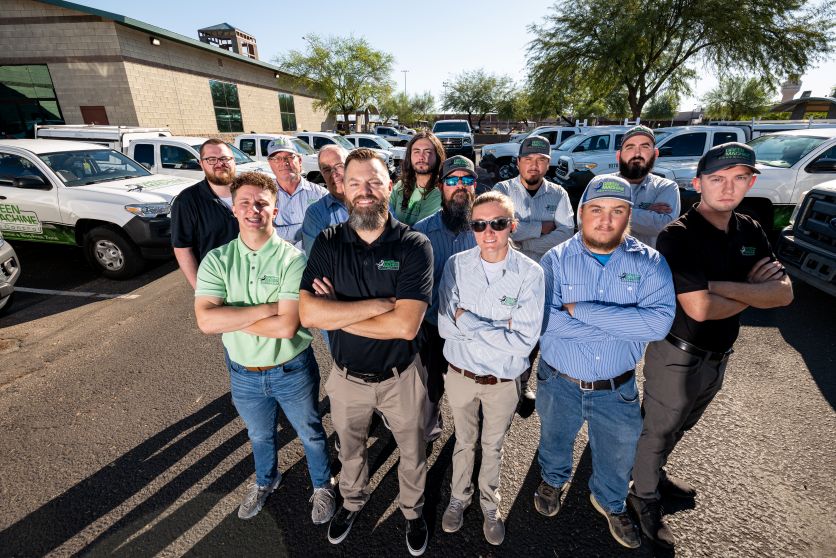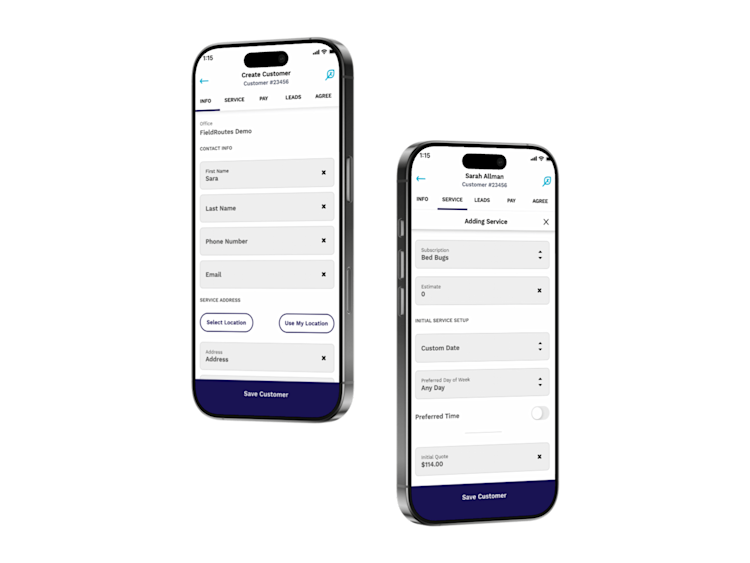Increase Pest Control Revenue: 7 Proven Growth Strategies

Scaling pest control revenue comes with challenges like high customer turnover, inefficient operations, and competition. To grow, you need the right strategies and technology.
The U.S. pest control industry was worth over $24.2 billion in 2024 and is growing, so business owners have many opportunities. This guide will give you actionable tips to increase revenue, improve customer retention, streamline operations, and use digital tools effectively.
What Challenges Do Pest Control Businesses Face in Increasing Revenue?
Pest control businesses face many barriers to scaling revenue, from inefficient operations to marketing challenges. Addressing these would help increase profitability and long-term growth.
Here are the main challenges:
Inefficient operations: Disorganized processes like manual scheduling or delayed invoicing waste time and resources. Inefficiencies reduce operational efficiency, increase operating costs, and lower cash flow that could be used for business growth.
Limited service diversification and value optimization: Sticking to basic pest control services limits revenue. Additional services like termite control, lawn care, or bundled packages can attract a broader customer base and higher profit margins.
Difficulty retaining customers long term: High customer turnover means finding new customers instead of capitalizing on repeat business. Not implementing loyalty programs or following up reduces customer retention and profitability.
Local and digital marketing reach: Many businesses struggle to optimize their digital presence. Poor SEO and limited social media engagement make attracting customers in competitive markets harder, especially for local pest control companies.
Lack of data-driven decision-making: Without tools to track metrics like customer feedback, service quality, or technician performance, decisions are made based on gut fee,l and growth opportunities are missed.
Training and team performance: Insufficient training and a lack of focus on professional development lead to inconsistent service quality, unhappy customers, and inefficient teams.
Difficulty setting a competitive pricing strategy in a crowded market: Setting a competitive pricing strategy can be tricky and impact revenue growth, especially for new and local businesses trying to stand out.
Addressing these challenges can unlock new revenue for pest control business owners.
Next, we’ll discuss actionable tips for increasing revenue and streamlining operations.
How Can You Increase Revenue and Profitability for Your Pest Control Business?
Focusing on revenue drivers, optimizing services, and investing in customer retention can increase your bottom line.
Add digital marketing, team training, and data-driven decisions, and you’ll have long-term growth. Below, we’ll outline the steps to help pest control businesses scale efficiently and ensure customer satisfaction.
Know your revenue drivers: Which services and customer segments generate the most revenue? For example, pest management packages or commercial clients have higher profit margins. Review your pricing strategy regularly to stay competitive and maximize profit margins. Understanding and implementing common pricing strategies is key to being competitive.
Optimize your services for value: Add in-demand services like termite treatments or lawn care. Introduce bundled pest control services to encourage repeat business and give more value to your customer base.
Operate more efficiently: Use pest control software like FieldRoutes to automate scheduling, invoicing, and customer communication. Simplifying these processes reduces errors, saves time, and improves cash flow management.
Invest in customer retention: Build customer loyalty by introducing referral programs, offering discounts for repeat business, and collecting customer feedback to improve service quality. Retaining customers increases lifetime value and stabilizes revenue streams. Value-based pricing is particularly effective in enhancing customer satisfaction and loyalty.
Use digital marketing for growth: Digital marketing should be part of your pest control marketing from the outset. Optimize your website for SEO to rank higher in local search results for terms like “pest control services near me.” Use social media to reach potential customers and promote your pest control business through targeted ads and content.
Train your team for better performance: Update employee training programs regularly to ensure technicians deliver consistent, high-quality service. Focus on skills like sales upselling, safety compliance, and customer communication to drive revenue growth and customer experience.
Use data and analytics to make decisions: Use real-time dashboards to track customer satisfaction, task completion rate,s, and team performance. Data will help you identify growth opportunities and areas for improvement so you can make informed decisions.
Pest control business owners can achieve long-term revenue growth by following these tips.
Next, we’ll show you how FieldRoutes' tools can help you further.
1. Understand Your Revenue Drivers
Revenue maximization starts with knowing what drives it.
For pest control businesses, primary revenue sources are core services like pest management, upselling additional services, and retaining repeat clients. Knowing these sources allows you to focus on high-impact areas and make informed decisions for growth.
Different pricing models, such as subscription or dynamic pricing, can help you align your services with market conditions and customer behavior.
Customer Lifetime Value (CLV) is a customer's total revenue during their relationship with your business. For example, a happy client getting regular termite inspections will generate more revenue than one-time customers. Increasing CLV by improving customer retention and upselling additional services significantly impacts profitability.
Track these metrics to measure revenue growth:
Average transaction value: Measure the revenue per service visit to identify opportunities to upsell or bundle pest control services. Finding the right price is critical to balancing customer satisfaction and profit.
Customer retention rate: How often do customers return for repeat services to measure your loyalty strategy success?
Profit margins by service type: Which services have the highest profit margins and allocate resources accordingly?
New customer acquisition costs: How much do you spend to get new clients compared to the revenue generated?
By focusing on these revenue drivers, pest control business owners can identify strengths, reduce waste, and achieve consistent growth.
Next, we’ll show you how to optimize your business operations for maximum value.
2. Optimize Your Services for Maximum Value
Optimizing your service offerings greatly increases revenue and your pest control business’s competitive advantage. Diversifying services, adding complementary services, and strategic pricing can attract new customers while encouraging repeat business.
Expanding your service range can increase profitability. For example, seasonal pest control packages can be offered that target specific infestations, such as ants in summer or rodents in winter. Bundling services like termite treatments with regular pest management plans gives customers more value and encourages higher transaction amounts. Try different price points for these bundles to find the sweet spot for maximum sales and profitability.
Adding complementary services is another way to maximize revenue. Sanitation or disinfection services fit well with pest control by addressing hygiene-related pest problems. For example, offering attic cleanouts or crawl space sanitization after rodent infestations expands your service scope and positions your business as a full-service provider.
Implement pricing that reflects your value and market position. Consider tiered pricing, where customers can choose from basic, premium, or deluxe pest control services to match their budget. Ensure your pricing is competitive but justify higher rates with better service and customer experience. Choose the suitable pricing method (premium or penetration pricing), differentiate your services, and attract customers.
Optimizing services diversifies revenue streams and improves customer satisfaction and loyalty.
Next, we’ll examine how improving operational efficiency can drive profitability.
3. Improve Operational Efficiency
Improving operational efficiency is required to increase pest control business profits. By streamlining scheduling, automating tasks, and embracing digital tools, you can save time, improve service delivery and increase revenue.
Efficient scheduling and route optimization reduce time and fuel costs. Pest control software can assign technicians to jobs based on proximity, skill sets, and availability. Optimizing routes for a day of termite treatments minimizes travel time, allowing more appointments to be completed.
Automate routine tasks. Such as invoicing, follow-ups, and reminders. Automating these tasks reduces errors, speeds up payments, and ensures timely customer communication. For example, automated reminders for overdue invoices keep cash flow and customer retention consistent.
Digital record keeping. Improve tracking and decision-making. A centralized system to store service histories, customer feedback, and technician performance metrics. This allows business owners to analyze trends, optimize operations, and address issues proactively. For example, more manageable pesticide usage tracking or recurring pest problems can help refine service offerings.
By improving operational efficiency, pest control business owners can cut costs, improve service quality, and increase revenue.
Next, we’ll examine customer retention strategies to drive long-term profitability.
4. Invest in Customer Retention Strategies
Customer retention is the key to revenue growth for pest control businesses. Repeat business means steady cash flow, reduced marketing costs, and a stronger customer base.
It’s much cheaper to retain existing customers than to acquire new ones.
Pest control companies can build long-term relationships with customers by focusing on loyalty programs, subscription services, and consistent communication.
Reward loyalty with programs or subscription services. Loyalty programs encourage repeat business by rewarding customers with discounts or perks for continued engagement. For example, offering a free pest control service after several visits encourages customers to return. Knowing your target market allows you to tailor these programs to their needs and preferences. Subscription models like annual termite treatment plans or seasonal pest management provide predictable revenue and convenience for customers.
Communicate with customers consistently. Proactive communication, such as follow-up calls after services or reminders for upcoming appointments, shows customers you value their business. Sending customer satisfaction surveys also provides valuable feedback and shows you care about service quality.
Provide a better customer experience. Exceeding expectations by delivering on time, addressing customer concerns quickly, and offering custom solutions creates loyal customers who will recommend your business.
Pest control businesses can use these retention strategies to build trust, attract long-term customers, and drive sustainable revenue growth.
Next, we’ll examine how digital marketing can help you expand your reach and profitability.
5. Leverage Digital Marketing for Growth
Digital marketing offers pest control businesses the tools to attract new customers, engage existing ones, and increase revenue.
Optimizing your website, targeting social media users, and creating valuable content can position your business for success.
Here’s how:
Optimize your website for local SEO: Use keywords like “pest control services near me” and “termite treatment” to rank higher in search results. Create service-specific pages for services like seasonal pest management or lawn care. Ensure your Google Business Profile is up to date with your contact information and customer reviews to attract local leads.
Use targeted social media ads: Platforms like Facebook and Instagram allow you to target ads to specific demographics like homeowners in your area. Highlight seasonal offers or tips like “Winter Rodent Prevention Services” to grab attention. These ads drive traffic to your website and convert leads into paying customers. Consider using penetration pricing in your digital marketing campaigns to attract new customers with initial discounts.
Use content marketing: Content marketing strategies like publishing blogs, videos, and infographics that educate and engage potential customers. Topics like “How to Handle a Bed Bug Infestation” build trust and position your business as an expert. Share this content across email newsletters and social media to amplify reach and credibility.
Digital marketing grows your customer base and visibility.
Next, we’ll examine how training your team can improve service quality and profitability.
6. Train Your Team for Better Performance
Your team is pivotal to delivering quality service and driving revenue for your pest control business.
Skilled, customer-focused technicians ensure customer satisfaction, repeat business, and your reputation. Investing in training and incentives keeps your team motivated, productive, and aligned with your business goals (and should stop them from leaving your business!)
Train your team in ongoing customer service and technical skills: Give your technicians up-to-date knowledge on pest control techniques, safety protocols, and communication. For example, train your team on the safe use of pesticides or how to identify termite activity. Pair technical training with customer service workshops to improve professionalism and build stronger customer relationships. Also, technicians should be trained on the best pricing strategy to improve their upselling skills and customer interactions.
Use incentive programs to motivate: Reward technicians for outstanding performance, such as upselling targets or positive customer reviews. Incentives like bonuses, extra time off, or recognition at team meetings will engage employees and encourage them to do their best.
Create a culture of personal growth: Offer certifications, workshops, or access to industry events to keep your team up to date with pest management trends. Continuous development will keep technicians confident and committed to delivering quality service.
A trained and motivated team is the foundation of your pest control business.
Next, we’ll examine how to use data and analytics to make decisions and drive growth.
7. Utilize Data and Analytics to Guide Decisions
Data and analytics are powerful tools for pest control businesses that want to improve efficiency, increase revenue, and stay ahead of the competition.
Tracking performance metrics, analyzing customer trends, and using insights to refine strategies will lead to better decision-making and growth.
Track performance with KPIs for business intelligence: Key Performance Indicators (KPIs) like customer retention rates, task completion times, and average transaction values will give you a clear view of your business. For example, tracking how long it takes to resolve pest problems like ant infestations will highlight areas for improvement in efficiency. Pest control software with real-time dashboards makes KPI monitoring and reporting easy.
Analyse customer trends to offer services: Use data to see what services are in demand or seasonal pest problems. For example, if you see a surge in rodent control requests in colder months, you can market related services to your customer base. Customer feedback and reviews will also give you insights to improve your service offerings.
Use data to adjust marketing and operational strategies: Analytics will refine digital marketing by showing which campaigns generate the most leads. Operational data, such as technician performance or pesticide usage, will help optimize workflows and reduce labor costs.
Using data means your pest control business runs smoothly and meets customer needs.
Next, we’ll look at how FieldRoutes can help you implement these strategies and grow long-term.
How Can FieldRoutes Help Boost Revenue for Your Pest Control Business?
FieldRoutes has tools to streamline operations, customer management, and marketing, which will drive revenue growth. Its easy-to-use platform will save you time, optimize processes, and deliver outstanding service.
Automated Scheduling and Route Optimisation: FieldRoutes automates technician scheduling and optimizes routes to reduce travel time, fuel costs, and efficiency.
Customer Relationship Management (CRM): The CRM allows businesses to manage customer interactions, track service history, and follow up to improve customer retention and loyalty.
Billing and Invoicing Automation: Automated billing and invoicing make payment collection easier, reduce errors, and improve cash flow management—less admin.
Comprehensive Analytics and Reporting: FieldRoutes gives you real-time insights into metrics like technician performance, customer retention rates, and revenue trends to make data-driven decisions.
Digital Marketing Integration: FieldRoutes integrates with your marketing efforts. Digital marketing tools can help you optimize campaigns, attract new customers, and improve your pest control business’s online presence.
Using FieldRoutes, pest control businesses can become more efficient, build customer relationships, and grow revenue over the long term.
It’s Your Turn Now
Growing your pest control business means strategically optimizing services, improving operational efficiency, and digital marketing.
Invest in customer retention, train your team to perform better, and use data and analytics to make business-critical decisions.
Explore more tips to grow your business from our blog.
Ready to take the next step? Schedule a free demo with FieldRoutes today!





![10 Pest Control Tools Every Technician & Company Needs [2025]](https://images.ctfassets.net/7i0yc949tatx/7cqTUOBQEUPSU4570lOSRf/be27fcb0297c1dd6fcab89b0a53094a7/FRT-Blog-Best-Pest-Tools-0623-PL.jpg?w=720&h=360&fl=progressive&q=100&fm=jpg)